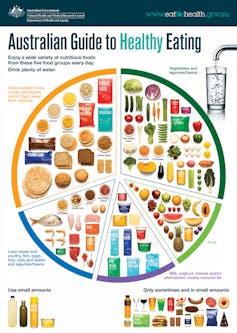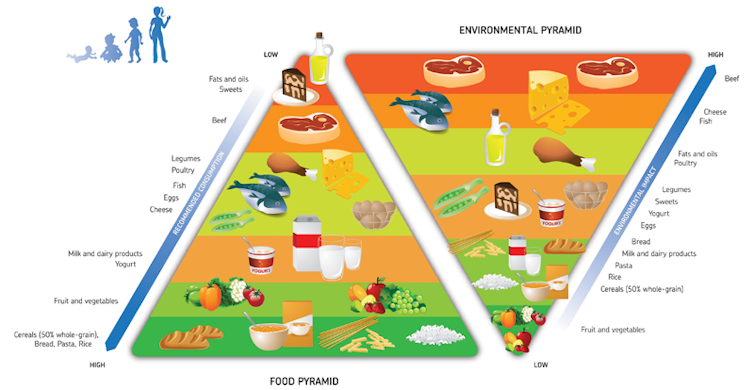The way we currently produce food around the world contributes up to 20-30% of the world’s greenhouse gas emissions and accounts for 70% of all human water use.
But is it possible to eat well and take better care of the Earth at the same time?
Knowing what’s good for you

The Australian Guide To Healthy Eating recommends eating a variety of nutritious foods including vegetables, fruit, grain and lean meat to achieve a balanced healthy diet.
This guide indicates the need to increase the consumption of cereals, legumes, vegetables and fruit, while consuming meat, fish and dairy products in lesser quantities.
Meat is an important source of protein and certain micro-nutrients, including iron, zinc and vitamins and milk is a rich source of protein and calcium. That’s why the Australian Guide recommends two daily serves of milk and dairy products, along with two serves of meat, fish and eggs.
Protein intake is important for a balanced diet, as insufficient protein intake can lead to obesity due to excessive carbohydrate and fat intake to meet energy requirements.
Plant foods – including grains, fruits, vegetables and legumes – are also vital for keeping us healthy. That’s why the Australian Guide To Healthy Eating recommends a higher consumption of plant foods each day, along the lines of seven serves of cereals, five serves of vegetables and legumes, and two serves of fruit. Doing that can reduce the risk of obesity, diabetes, heart disease and some types of cancer, and increase life expectancy.
The global impacts of our diet
The United Nations’ Food and Agriculture Organization defines sustainable diets as:
Those diets with low environmental impacts which contribute to food and nutrition security and to healthy life for present and future generations.
In developed countries like Australia and the UK, people tend to consume more meat and operate at a higher trophic level in the food chain.
At the lowest level of the food chain (trophic level 1) are primary producers such as plants, followed by plant-eating animals such as cows, goats, horses and kangaroos. Then come animals that eat other animals, and then the apex or super predators at the top of the food chain (including carnivores like crocodiles, lions and killer whales).
Between each trophic level, there is a loss of energy. That’s why, for example, production of livestock, on average, may require 4 kg of cereal grain for the production of 1 kg of meat.
The rearing of livestock for meat, eggs and dairy also generates 14.5% of total global greenhouse gas emissions, mainly from methane produced during digestion in grazing animals such as cattle and sheep. If people consumed more crops directly, rather than their processing through livestock, there will be a positive environmental impact.

The Double Pyramid developed by the Barilla Centre for Food and Nutrition in Italy shows the synergies between food that is good for our health and environment.
This model consists of two pyramids: one is the traditional food pyramid similar to the Australian guide, while the other is an upside-down pyramid ranking the environmental impacts of the same foods. In general, foods at the base of the food pyramid are also those with the lowest environmental impact.
Eat your cereal, beans and vegetables
Cereal grain crops are primary producers and have a lower water and carbon footprint.
Legumes such as chickpea and lentil have less than half of the greenhouse emissions of other cereal crops, as they are able to fix nitrogen naturally from the air and do not require any nitrogen fertilisers.
Compared with animal products, emissions from vegetables are lower on a per tonne basis. Most emissions associated with vegetable production come from fertiliser use, electricity use and post-harvest refrigeration and transport.
Even a modest replacement of energy-intensive animal products with less-energy-intensive grains, fruits and vegetables would be significant at the global scale.
Rethinking healthy diet advice
Given that fewer than 3% of people in Australia and the UK are vegetarian, it’s unrealistic to suggest a meat-free diet for everyone.
Instead, it may be more realistic to encourage people to replace quantities of red meat and processed meat with lean, less environmentally-harmful meat options such as chicken, and plant-based proteins such as legumes.
In Australia and New Zealand, grazing animals are mainly grass-fed rather than grain-fed (more common in the US), which may play an important role in soil carbon sequestration in grasslands, which reduces greenhouse gas emissions.
If a healthy and sustainable plant-based diet is better for our health and environment, why is it that consumption of plant foods in many developed countries does not meet recommended levels?
In Victoria, for example, fewer than 8% of adults consume the recommended daily intake of five or more serves of vegetables, and fewer than 46% eat the recommended daily intake of two or more serves of fruit.
The recent Australian Health Survey found that one in four adults were eating no vegetables on an average day and only 7% were eating the recommended five servings.
An energy-dense diet made up of refined grains, added sugars and added fats may also be more affordable than a healthy and sustainable diet based on fruits and vegetables and lean meats.
Australian governments could help promote a healthier diet by considering educational and policy measures, such as reinstating the healthy-food star rating systems and restricting junk food promotion.
Given the rapidly rising costs to all Australians of our growing waistlines – 25% of us are now obese, one of the highest rates in the world – failing to act is already proving extremely expensive, in both personal and economic terms.
It’s also up to each of us to make healthier choices, for our own sake, as well as for the environment that our children will inherit from us – and that starts with the food we eat today.

